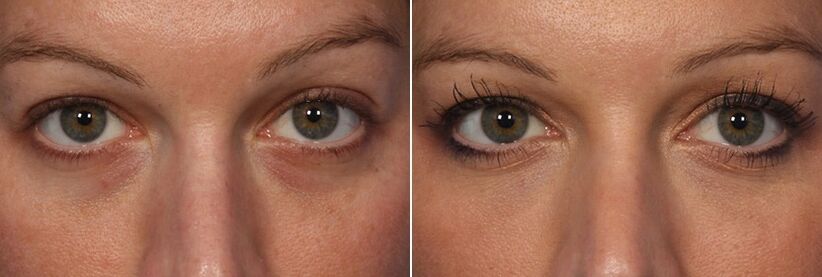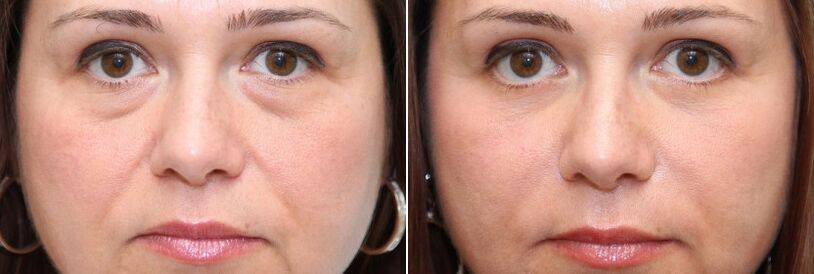
The eyes are the most important in determining whether a face is attractive or tired. An experienced eye can instantly determine all the secrets of our lives and inheritance, looking only at our eyes. In medical terms, our bodies go through a series of changes as we age, and the first signs of these changes are in the vulnerable areas around the eyes.
For some, these signs appear earlier, for others - later, but many of us wonder: what causes wrinkles and droopy eyelids, and what can be done about itCome join the Forever Young Eyes Owners League.
Demystifying aging eyes
Not only is Blepharochalasia a weird, hard-to-pronounce word, it's a medical term used to describe the effects of excess skin around the eyes or heavy eyelids. This is a fairly common problem caused by the normal aging process, fatigue, allergies, slow lymphatic drainage, or many other medical conditions.
What are the characteristics of the skin around the eyes and why is it so delicate?
1. Aging
In general, the skin around the eyes is seven to ten times thinner and more delicate than the skin on the face and other parts of the body. With age, the skin becomes thinner due to the loss of collagen, elastin and hyaluronic acid (which keeps the skin hydrated). Delicate skin is elongated by the action of the fat body, resulting in visibly sagging under-eye bags. Prominence of infraorbital fat is considered a common manifestation of the aging process. In addition, aging and many other factors can affect the weakening of muscles, which can only make the condition of eye bags worse.
2. Genetic causes
Researchers recently conducted a study to identify risk factors for ptosis, with a particular focus on genetic factors. They studied two groups of people. The first group consisted of 5578 unrelated persons. 17. 8% of the participants in this group had moderate to severe ptosis. In the second group, 2, 186 were twins, and 61 percent of the participants in this group had inherited ptosis. These findings support the fact that the most common cause of ptosis is genetics.
3. Sebaceous glands
The periorbital area is drier because there are fewer sebaceous glands than the skin on the rest of the face. As a result, she has a worse lipid barrier and is more prone to mimetic wrinkles.
4. Skull
Prominent cheekbones and sunken eyes. This is the reason for the sunken under eye, the shadow of which creates the illusion that the skin under the eye is darker, even if it isn't. As you age, the facial bones of the skull change, and this only gets worse.
5. Translucent capillaries
Dark circles are actually the result of hemoglobin oxidation. Hemoglobin, the main component of red blood cells, contains a heme group with iron atoms bound to oxygen molecules.
In this way, red blood cells carry oxygen throughout the body and carry away all waste products for destruction. Red blood cells turn red when oxygen molecules attach to the heme group. When oxygen molecules are separated and hemoglobin is oxidized, red blood cells turn blue. This is why dark circles appear under the eyes. If red blood cells show through the capillaries around the eyes, enzymes in the body interfere with the movement of red blood cells and oxidize them, turning them blue. When this happens, waste products are released into the bloodstream and carried throughout the body. Translucent capillaries can also cause swelling or fluid retention in the body, making the face look puffy.
6. Toxins in the body
Dark circles under the eyes may indicate sleep problems or the presence of toxins in the kidneys or liver. According to Chinese medicine, the area above and below the eyes is the kidney area. Swelling and fluid retention in the area indicate excess fluid (watery and swollen circles with a blue tint) or excess mucus (fat and swollen with a yellow tint) in the body. White or blue circles under the eyes indicate fatigue or exhaustion. Yellow indicates poor liver and gallbladder function. If the gallbladder cannot handle and break down body fat, this can cause milia (tiny white-yellow bumps) around the eyes in some people.
7. Frequent eye movements
Your skin can be affected by your frequent blinking and facial expressions such as smiling (also known as expression wrinkles).
8. Iron
Iron may be another contributing factor. Red blood cells need iron atoms to attach oxygen molecules to themselves. When you have low iron levels in your body, red blood cells cannot attach oxygen to themselves, so the blue circles appear under the eyes.
9. Lifestyle
Puffy eyes are another problem that can occur regardless of age or gender. It is caused by a high-salt diet, smoking, or heavy drinking. Dark circles and early wrinkles also appear due to an unhealthy lifestyle.
If you're wondering how your eyes change as you age, look to your parents. This will give you a clear idea of whether you will have a large fat pad under your eye. But you can try altering the genetic program with the help of aesthetic medicine.
Other causes of deteriorating periorbital skin may be: stress, poor or poor nutrition, too much or not enough sleep, excessive use of makeup (remember to wash it off every night), frequent skin washing with products that dry out the eyes (avoid makeupalcohol) and sun damage - photoaging.
currently available treatments
Wrinkles, bags under the eyes, dark circles, and droopy eyelids are not only unsightly, but can also lead to vision problems and headaches (from constantly trying to keep your eyes open). There are many surgical and non-surgical treatment options for tired, sagging or aging eyelid skin.
The choice of eye rejuvenation approach depends on the type of disease we are dealing with. For example, aging skin on the upper eyelid may require tightening due to excess skin and muscle weakness. The lower eyelid may require treatment of puffy and thinned skin, as well as removal of fat sacs. Dark circles under the eyes require separate treatment.

Volume and Moisture: Filler
The easiest and most effective way to smoothen the skin around the eyes is to use injectable fillers. They provide a natural look to the skin and help combat sunken eyes. Fillers also improve under-eye circles by 15-20%, but they're pretty much useless in fighting cellulite. There are several specially formulated hyaluronic acid gels that reduce wrinkles around the eyes and impart volume and moisture to the skin.

laser skin rejuvenation
Laser surgery is a non-invasive way to tighten the skin around the eyes. CO2 laser rejuvenation or Fraxel is a very gentle method that gradually restores the youthful state of the eyelid skin and can be used concurrently with fillers or surgical techniques.
Lasers at the microscopic level cause thermal damage to the skin, to which the skin responds by rapidly healing and shedding old damaged cells. Old cells are replaced by new, younger cells. CO2 lasers can also improve skin elasticity and texture and reduce fine or deep wrinkles, acne scars and freckles.

Surgery: Blepharoplasty
Blepharoplasty (or eyelid reduction surgery) is used if non-surgical methods do not provide the desired results. This process is a very effective way to achieve the desired look.
The surgeon makes small incisions on the lids and under the eyes, removes excess fat and tightens the skin, and then closes the incisions. Removing the fat pads under the eyes can significantly reduce puffiness. Surgery can also remove droopy (droopy) eyelids, but it can't combat dark circles or sagging eyebrows -- issues that need to be addressed individually.
Blepharoplasty is the only way to remove prominent fat bodies, especially in people who are overweight (those who have excess fat accumulation under the eyes). But non-surgical methods do a good job of firming skin, wrinkles, and sunken eyes.














